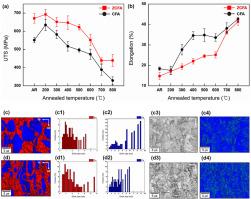添加Zr对变形和退火Cu-Fe合金组织演变和力学性能的影响
IF 6.6
2区 材料科学
Q1 MATERIALS SCIENCE, MULTIDISCIPLINARY
Journal of Materials Research and Technology-Jmr&t
Pub Date : 2025-09-16
DOI:10.1016/j.jmrt.2025.09.120
引用次数: 0
摘要
研究了添加Zr对Cu-Fe合金组织演变、再结晶行为和力学性能的影响。添加1wt %的Zr可生成Fe2Zr和ZrO2相;这一过程导致晶粒细化和位错密度增大。这些沉淀有效地阻碍了位错运动,有助于强化机制。Zr的加入显著提高了材料在大范围退火温度下的屈服强度和极限拉伸强度。晶界细化、加工硬化和析出对强化的贡献显著增加,因此在TANN = 400℃时,合金的强化强度为~ 141.71 MPa。此外,当TANN升高时,Zr抑制了Cu相的再结晶,同时加速了Fe相的再结晶,因此力学性能随TANN的变化而变化。这些结果为指导设计用于先进结构和电子应用的高强度,热稳定的Cu-Fe合金提供了新的见解。本文章由计算机程序翻译,如有差异,请以英文原文为准。

Effect of Zr addition on microstructural evolution and mechanical properties of deformed and annealed Cu–Fe alloys
The influence of Zr addition on the microstructural evolution, recrystallization behavior, and mechanical properties of Cu–Fe alloys was investigated. Addition of 1 wt% Zr led to formation of Fe2Zr and ZrO2 phases; this process resulted in grain refinement and increased dislocation density. These precipitates effectively hindered dislocation motion and contributed to strengthening mechanisms. Zr addition significantly increased the yield strength and ultimate tensile strength across a wide range of annealing temperature TANN. The strengthening contributions from grain-boundary refinement, work hardening, and precipitation were substantially increased, so the alloy was strengthened by ∼141.71 MPa at TANN = 400 °C. Additionally, at elevated TANN, Zr suppressed recrystallization of the Cu phase while accelerating that of the Fe phase, so the mechanical properties varied with TANN. These results provide new insights to guide design of high-strength, thermally stable Cu–Fe alloys for advanced structural and electronic applications.
求助全文
通过发布文献求助,成功后即可免费获取论文全文。
去求助
来源期刊

Journal of Materials Research and Technology-Jmr&t
Materials Science-Metals and Alloys
CiteScore
8.80
自引率
9.40%
发文量
1877
审稿时长
35 days
期刊介绍:
The Journal of Materials Research and Technology is a publication of ABM - Brazilian Metallurgical, Materials and Mining Association - and publishes four issues per year also with a free version online (www.jmrt.com.br). The journal provides an international medium for the publication of theoretical and experimental studies related to Metallurgy, Materials and Minerals research and technology. Appropriate submissions to the Journal of Materials Research and Technology should include scientific and/or engineering factors which affect processes and products in the Metallurgy, Materials and Mining areas.
 求助内容:
求助内容: 应助结果提醒方式:
应助结果提醒方式:


